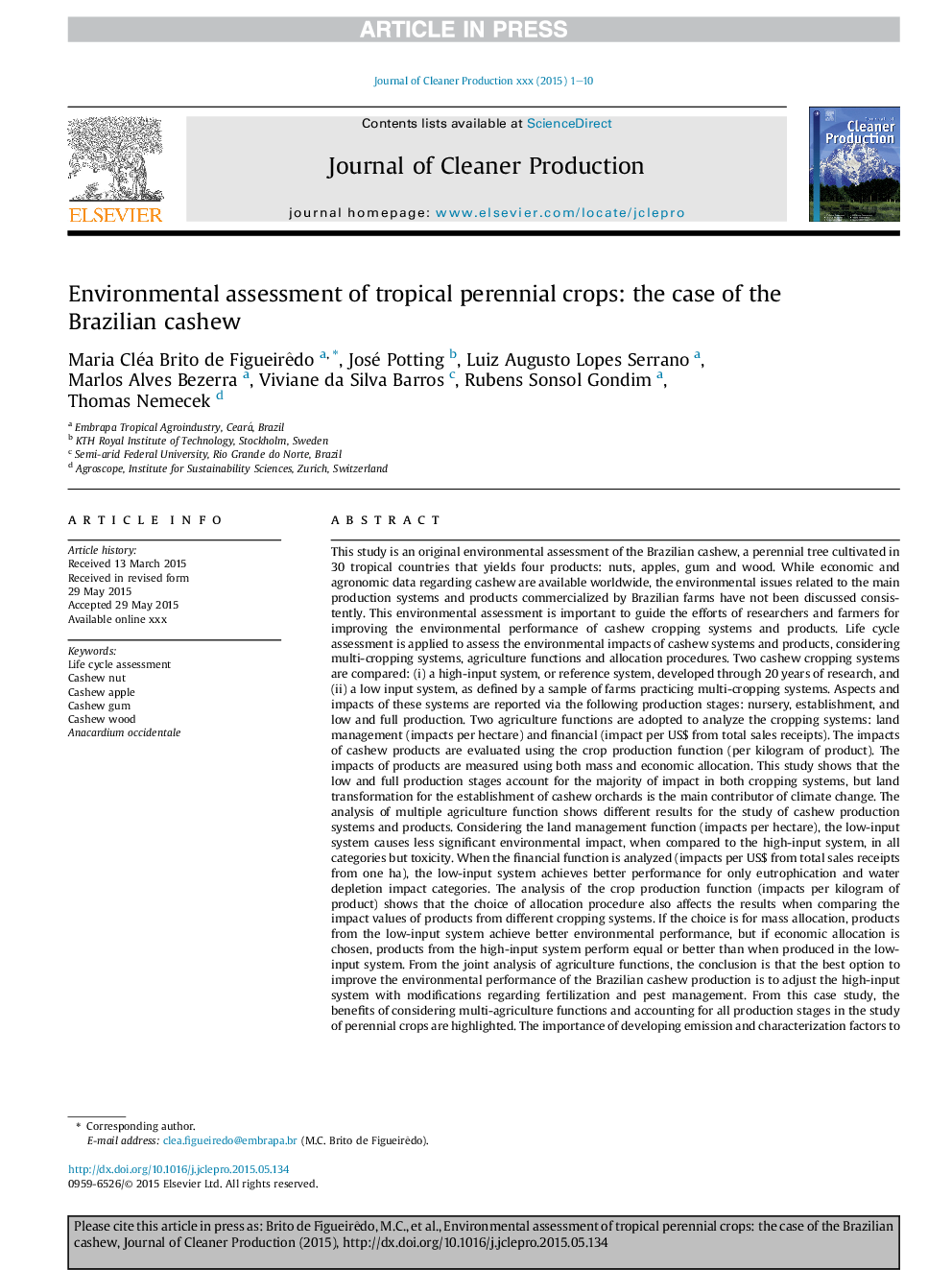| کد مقاله | کد نشریه | سال انتشار | مقاله انگلیسی | نسخه تمام متن |
|---|---|---|---|---|
| 10688021 | 1017970 | 2016 | 10 صفحه PDF | دانلود رایگان |
عنوان انگلیسی مقاله ISI
Environmental assessment of tropical perennial crops: the case of the Brazilian cashew
ترجمه فارسی عنوان
ارزیابی محیط زیست محصولات چندساله گرمسیری: مورد قهوه ای برزیلی
دانلود مقاله + سفارش ترجمه
دانلود مقاله ISI انگلیسی
رایگان برای ایرانیان
کلمات کلیدی
موضوعات مرتبط
مهندسی و علوم پایه
مهندسی انرژی
انرژی های تجدید پذیر، توسعه پایدار و محیط زیست
چکیده انگلیسی
This study is an original environmental assessment of the Brazilian cashew, a perennial tree cultivated in 30 tropical countries that yields four products: nuts, apples, gum and wood. While economic and agronomic data regarding cashew are available worldwide, the environmental issues related to the main production systems and products commercialized by Brazilian farms have not been discussed consistently. This environmental assessment is important to guide the efforts of researchers and farmers for improving the environmental performance of cashew cropping systems and products. Life cycle assessment is applied to assess the environmental impacts of cashew systems and products, considering multi-cropping systems, agriculture functions and allocation procedures. Two cashew cropping systems are compared: (i) a high-input system, or reference system, developed through 20 years of research, and (ii) a low input system, as defined by a sample of farms practicing multi-cropping systems. Aspects and impacts of these systems are reported via the following production stages: nursery, establishment, and low and full production. Two agriculture functions are adopted to analyze the cropping systems: land management (impacts per hectare) and financial (impact per US$ from total sales receipts). The impacts of cashew products are evaluated using the crop production function (per kilogram of product). The impacts of products are measured using both mass and economic allocation. This study shows that the low and full production stages account for the majority of impact in both cropping systems, but land transformation for the establishment of cashew orchards is the main contributor of climate change. The analysis of multiple agriculture function shows different results for the study of cashew production systems and products. Considering the land management function (impacts per hectare), the low-input system causes less significant environmental impact, when compared to the high-input system, in all categories but toxicity. When the financial function is analyzed (impacts per US$ from total sales receipts from one ha), the low-input system achieves better performance for only eutrophication and water depletion impact categories. The analysis of the crop production function (impacts per kilogram of product) shows that the choice of allocation procedure also affects the results when comparing the impact values of products from different cropping systems. If the choice is for mass allocation, products from the low-input system achieve better environmental performance, but if economic allocation is chosen, products from the high-input system perform equal or better than when produced in the low-input system. From the joint analysis of agriculture functions, the conclusion is that the best option to improve the environmental performance of the Brazilian cashew production is to adjust the high-input system with modifications regarding fertilization and pest management. From this case study, the benefits of considering multi-agriculture functions and accounting for all production stages in the study of perennial crops are highlighted. The importance of developing emission and characterization factors to reduce uncertainty when estimating pollutant loads and evaluating impacts of perennial crops cultivated in tropical regions is also discussed. This study advances the knowledge base on the environmental assessment of perennial crops in general, and on cashew crops specifically.
ناشر
Database: Elsevier - ScienceDirect (ساینس دایرکت)
Journal: Journal of Cleaner Production - Volume 112, Part 1, 20 January 2016, Pages 131-140
Journal: Journal of Cleaner Production - Volume 112, Part 1, 20 January 2016, Pages 131-140
نویسندگان
Maria Cléa Brito de Figueirêdo, José Potting, Luiz Augusto Lopes Serrano, Marlos Alves Bezerra, Viviane da Silva Barros, Rubens Sonsol Gondim, Thomas Nemecek,
